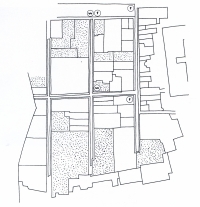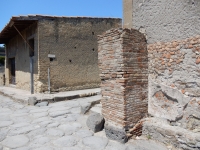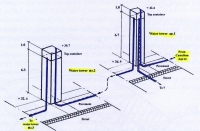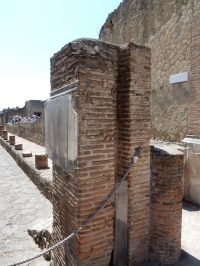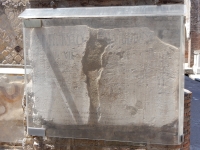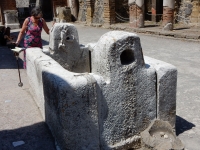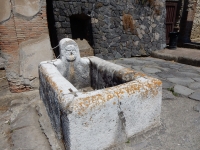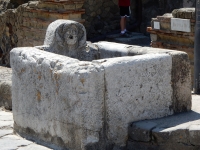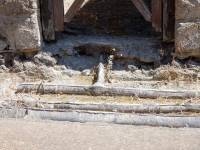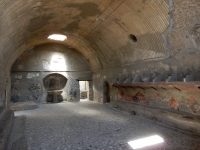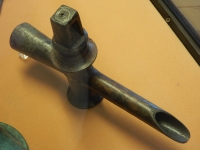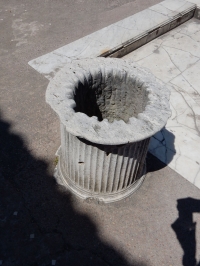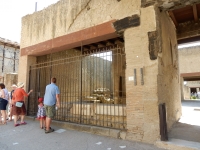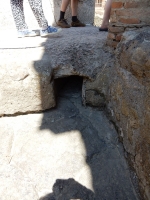Herculaneum (Italy)
Roman aqueducts: Herculaneum (Italy)
Ercolano - HERCULANEUM
The site of ancient Herculaneum is located beneath modern Ercolano between Mount Vesuvius and the Bay of Naples. The site - situated between two streams - is now some distance from the bay,
but prior to Vesuvius‘ eruption in 79 CE, Herculaneum was located directly on its shores. Herculaneum was controlled by the Samnites from the 5th c BCE and came under Rome‘s influence
from 307 BCE. It, along with Pompeii, revolted against Rome in the Social War and was conquered by Titus Didius, a legate of Sulla, in 89 BCE and became a municipium (town with Roman civil rights).
Unlike Pompeii, most of the site of Herculaneum remained unexcavated. This is largely due to the difficulty of removing the thicker and more dense overburden, resulting from the solidification of the mud
and ash that buried the town. Initially the site was excavated via a system of shafts and tunnels. During the twentieth century an area comprising eight insulae (blocks) and part of the decumanus maximus
(main street), was uncovered via open-air excavations. As a result, much of the water and wastewater systems remains to be discovered.
Herculaneum and Pompeii
The effects of the Vesuvius eruption of 79 CE were quite different for the surrounding cities: Pompeii was confronted with a gulf of ash and lapilli
(‘little stones‘: rock fragments formed by a lava spray). But a pyroclastic flow (stones, pumice, lapilli, water vapour and gasses -
up to 500 degrees C) struck Herculaneum later followed by a mud flood. That is why the effects were different for both cities, see the charred
beams in Herculaneum, absent in Pompeii.
A vivid description of the eruption and of the rescue operation of his uncle Pliny the Elder, can be found in two letters of Pliny the Younger
written to Tacitus, (Letters 6.16 and 6.20)
|
Water supply
Until now the actual aqueduct nor the castellum divisorium (the main water distribution station) of Herculaneum has been found. Given the (thin) calcareous layers (the so-called sinter) found at
different places in the water supply system, Herculaneum‘s water could have been originated from the major Aqua Augusta aqueduct north from Mount Vesuvius, or from an until now unknown source nearby.
Before the piped system, the water for the people in Herculaneum came from the two streams nearby, public and private wells and subterranean rainwater fed cisterns. There were quite a few houses
where the rainwater was directly sent into the drain, which suggests that the extensive network of wells guaranteed direct access to the water table.
And this water was of good quality, see the information box.
Teeth care
An interesting result of a study of skeletons found near the ancient beach at Herculaneum has been the very low incidence of tooth decay,
by either ancient or modern standards. Further investigation of the teeth revealed very high concentrations of fluorine in six out of the eight
individuals studied. The most likely explanation is that Herculaneum had a fluorinated water supply, millennia ahead of its time. Unlike
modern fluorinated systems, it seems that the fluorine was not intentionally added to the piped water system but was a naturally occurring
component of the groundwater at the site.
The two individuals with negligible dental fluorine concentration may have either drunk water almost entirely from the piped rainwater systems,
or may have had the extreme misfortune to have been visitors to the town on the 24th of August, 79 CE.
From: D. Keenan-Jones (2005)
|
Piped water infrastructure
The aqueduct water supply system was probably introduced during the reign of Augustus. As already been said: both the water supply line outside the city and the castellum divisorium (water distribution station) are not found yet.
Apart from three private towers within the premises of three houses, there are only two public water towers excavated so far. The towers - each about 1 x 1 m wide and at present 2,7 and 2,4 m high - were equipped with vertical groves
and a lead box (about 1 x 1 x 1 m) on top. Like the towers in Pompeii, the towers were built for water pressure reduction because Herculaneum also was built on a sloping table-land. The other purpose of the towers was the distribution
of water amoung its users in the direct neighbourhood to which the water was transported by means of lead pipes.
On the east side of the northern water tower two Latin inscriptions were found. The first - the most recent one from 60 - 70 CE - reads as follows:
CIL 4.10488
M. [ALF]CIUS PA[UL]US
AEDIL[IS]
[SI QU]IS VELIT IN HUNC LOCUM
STERCUS ABICERE MONETUR N[ON]
[LICERE] IACERE SIQUIS ADUER[SUS EA]
I[N]DICIUM FECERIT LIBERI DENT
[DENA]RIUM N SERVI VERBERIBUS
[I]N SEDIBUS ATMONENTUR
From: Schubring 1962
|
In translation:
M. [ALF]ICIUS PA[U]LUS
AEDILE
[IF ANY]ONE WISHES TO DISPOSE OF DUNG
IN THIS PLACE, HE IS ADVISED THAT IT IS N[OT]
[PERMITTED]. IF ANYONE ACTS CONT[RARY]
TO THIS NOTICE, FREE PERSONS MUST FORFEIT
[? DENA]RII. SLAVES WILL BE PUNISHED BY
BEATINGS [T]O THEIR REARS
Translation by Ducan Keenan-Jones (2005)
|
One of the duties of the Aediles - junior magistrates - was the maintenance of the aqueduct, streets and sewers. The purpose of the decree will have been to safeguard the purity of the water system
especially the public fountain nearby, and / or to keep the streets clean of dung.
The other, older inscription (AD 50) is beneath the previous one and reads:
CIL 4.10489
M. RUFELLIUS RO[MANUS?] ===== A. TETTEIUS SE[VERUS?]
II VIR[I IURE] ===== DIC(UNDO).
B(ONUM) F(ACTUM). AD LAEV[AND...]. ===== [....]PU[.......]ERTE UT[ ... ]PE[...]E
[E]DICEMUS HS XX SI [PRIM- vel LIBER]OS T[ .. ] PRAESENT[.. ] === HS N. SERVOM
VERBERIBUS COERCUERAMUS
From: Corpus Inscriptionum Latinarum (CIL) vol IV supplementi pars III (1952 - 1970)
|
In translation:
M. RUFELLIUS RO[MANUS?] A. TETTEIUS SE[VERUS?]
DUOVIR[I IURE] DIC(UNDO)
MAY IT BE A GOOD ACTION! TO THE LEFT(?)...THAT...
WE PROCLAIM 20 SESTERTII IF FREE PEOPLE (?)
SESTERTII...PRESENT...WE WILL PUNISH SLAVES WITH
BEATINGS
Translation by Ducan Keenan-Jones (2005)
|
Water users
The water towers were the feeding instruments to the public fountains, private houses, the workshops and the baths in Herculaneum.
Until now three fountains have been excavated: the Venus fountain (north - capacity 2.9 m3), the Hercules fountain (northeast - 2,5 m3) and the Neptune fountain
(east - 1,8 m3), made out of limestone including carved images on the headstones. The capacity of the Herculaneum fountains (mean of the known ones 2,4 m3)
seems larger than the ones in Pompeii (most ones about 1 m3 each) which may underline the importance of the public water supply in Herculaneum.
On a few places some lead pipes are visible in situ in the side-walks of the main streets, like the ones at the north side of cardo IV, almost in front of the northern
water tower; at one of the pipes a branch was made to the private House of Apollo the lyre player (V.9). Only a few (12) other houses (including some with a private
nymphaeum) had a private connection to the public water supply. Probably some workshops will have had a connection too but at present only in one occasion
(of the House with the mosaic of Neptune and Amphitrite) is known that the public water supply fed a shop, in this case a wash-room.
At the south side of the Decumanus Maximus, west of the northern water tower, the workshop of a plumbarius (plumber) has been identified, but without a water connection.
Two bath establishments have been excavated until now: the Suburban baths, with a presumed connection to the piped water supply, and the Forum baths. Before the
construction of the aqueduct the latter one was supplied with water from a local well plus a buckets and chain-mechanism; in later years the baths were fed with water
from the aqueduct by means of a special lead pipe.
Wilke D. Schram
The text was derived and partly copied from the literature presented below.
Wilke Schram
Ercolano - HERCULANEUM
| Item
| Info
|
| Length |
unknown |
| Cross-section |
unknown |
| Volume |
unknown |
| Fall |
unknown |
| Period |
Augustan ? |
| Features |
- 2 water towers
- 3 fountains
|
| Recommended literature :
|
- K. Schubring (1962): Epigraphisches aus Kampanischen Städten (in: Hermes, Zeitschrift für klassische Philologie vol 90-2 (1962) pag 239 - 244)
- G.C.M. Jansen (1991): Water systems and Sanitation in the houses of Herculaneum (in: Mededelingen van het Nederlands Instituut te Rome - Antiquity vol 50 (1991) pag 145 - 166)
- G.C.M. Jansen (2002): Water in de Romeinse stad: Pompeji - Herculaneum - Ostia (PhD-thesis, in Dutch)
- D. Keenan-Jones (2005): Water supply and wastewater disposal in ancient Herculaneum: an overview (in: Ancient History, resources for teachers, vol 35 (2005) pag 65 - 89 (on the web)
- D. Camardo and others (2006): Water supply and drainage at Herculaneum (from: G. Wiplinger (ed): Cura Aquarum in Ephesus 2004 vol 1 (2006) pag 183 - 191)
|
| Recommended websites :
|
|
| How to visit :
| By Circumvesuviana train adjacent the main train station of Naples, direction Salerno.
Stop at Ercolano Scavi and walk downwards (10 minutes) to the main entrance.
|
